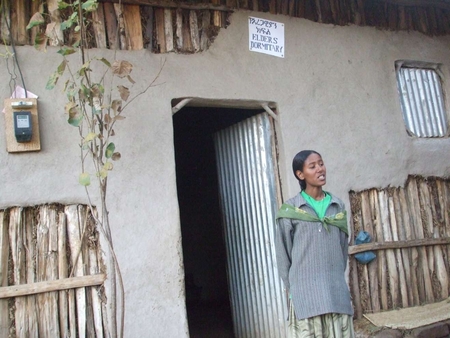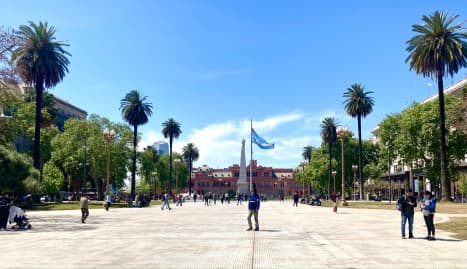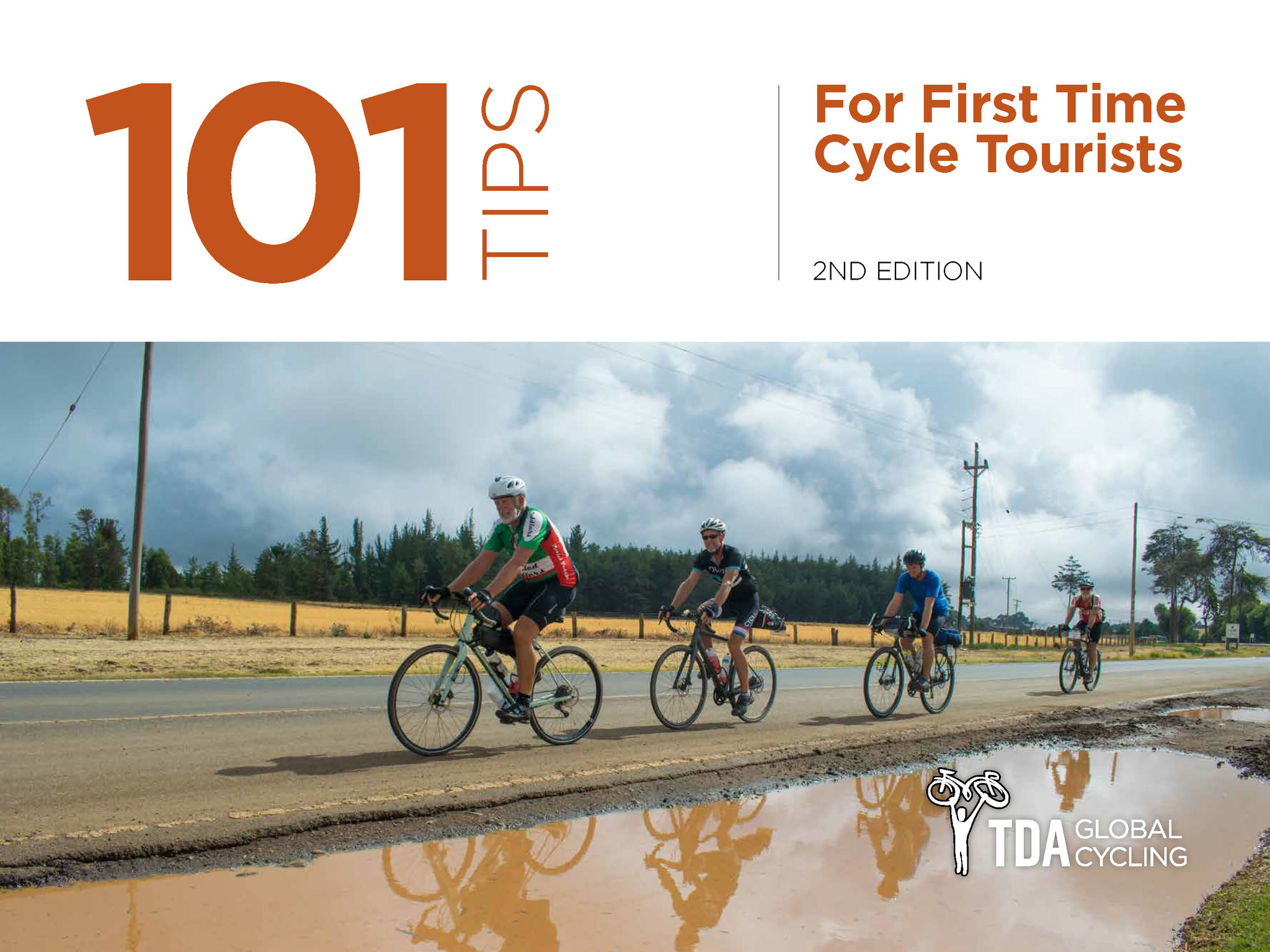Blog
“Why not have Paradise on Earth?”

I am siting in camp, drinking some delicious soup and chatting and laughing with a few riders about the day's easy and beautiful ride, spinning up hills to accomplishment and breathtaking views, and tearing down 4 kilometer long downhills passing goats and cows and children wearing long scarves and carrying sticks to lead their cattle with. As I slurp up the last bit of my soup, I decide to go for a walk. Barely out of the camp perimeter, I am completely surrounded by children asking me for my shoes and my shirt and pens. I decline and they take my hands and continue to beg as I find a way to continue to walk. Soon, some older boys who speak English quite well join us and I sit down surrounded by these children, answering their questions about what I am doing here, where I have come from, which country is best out of Egypt, Sudan and Ethiopia, where I am going, what grade I am in, where I am from, how old I am, what my parents do for a living, if I am married, if I have children… the list goes on. In turn, they answer the few questions I am able to squeeze in about what they study in school and what they do when they are not in school. (They study 10 subjects: math, English, biology, chemistry, physics, Ahmeric(the local language), gym, history, and two more I cant seem to remember or find, and they only go to school in the morning; in the afternoon they work alongside their parents). They are most impressed with how white the skin is on the underneath of my upperarms, which get little sun exposure, and the fact that I have no religion. This seems to horrify them and they ask puzzled why I am wearing a necklace then (a simple little seahorse on a black string my sister gave to me before I left). The children here almost all wear crosses around their necks, most of which are wooden. Finally, I decide to make my way back to camp and try to explain to them that I want to go alone (it is common that the children steal from us and so we try to discourage them from coming too near our camp). They get the idea and I say "chow!" and head back to camp. Little do I know that the adventure tonight in discovering the local culture has hardly even begun!
Back in camp, my fellow rider Dana, whom visited a local village with me before, asks me if I know anything about the commune nearby we had briefly heard about. After some investigating we find three more people who are interested and our Ethiopian support staff generously offer to take us there, help translate and bring us back! Set, we all load into the van and are off! After a stretch on a narrow paved road and then another stretch on a narrower dirt and stone road, we roll into a small village. Instantly, a sense of peace that brings us back to the deserts and villages of Sudan washes over us. Wondy, our confidant, well informed and friendly Ethiopian support staff leader, speaks with a woman and within 2 minutes our tour is under way. The woman is a teacher in the community and speaks English quite well. She and Wondy explain to us the short but inspiring history of the community as we make our way toward the school house.
In 1980 of the Ethiopian calendar (1987 of the Gregorian calendar used in the west), Zumra Nuru moved to the area we are visiting (all land in Ethiopia is owned by the government and loaned out for 100 year periods) with the intention of founding a community based on his vision of a paradise on earth. Today the population of what is now called Awuraamba Community is 412 and anyone at all is invited to join, provided they meet and accept the criteria: no lying, no stealing, no corruption, and treat everyone equally as human beings. The last criteria is the big one that the whole community is based around.
Unlike most of Ethiopia, where there is segregation in household roles performed based on gender, in Awuraamba, no matter what your gender, age or background, your abilities determine your job. In this self-sustained community both men and women tend to the cattle, farm, cook, look after the children and weave cloth. The children's days are broken up into thirds: school, work (helping their parents) and play. Education is highly valued here. The children start their education young learning the alphabet as well as the community's values and customs ("Why wait for education?" asks our guide). Once they are eight years old, they attend a government school in a local village. If an adult joins the community, they are equally granted an education: the community teaches them to read and write and then funds their education in a university nearby.
As the tour progresses from the school house (an endearing mud and thatch building decorated with colourful drawings) to the library, we learn a little more about how the community is able to fund such things as education and acquire things they cannot make themselves, such as books. Since the community is now recognised both by the Ethiopian government and the United Nations as a distinct community, books and some funds are donated to the community. Individuals and groups donate as well. Also, as we see later in the tour, the community makes excess cloth items to sell to people outside of the community (and adults can make extra extra after they are done their community work for some extra personal income) . We leave the library, where the children were remarkably focused, hardly taking notice of us at all.
Next, we move on to the elderly quarters: another mud and thatch building, the inside a series of cubicles for the elderly or ill inhabitants to sleep in made from the same mud as the walls as seamless protrusions. Our guide explains to us that in the community, when people become old or ill and cannot work, the community takes responsibility and cares for them. Zumra Nuru felt that when he were to grow old and tired, he would like to be taken care of, and so he will do the same for others. "Why not have paradise on Earth?" our guide asks simply, and a slow smile forms on our lips. I shake hands with a couple of the calm elderly folk who are resting in the shade and am hurried to join the group, where we find ourselves inside one of the 119 houses.
Before I describe this ingenious house, I want to add that in the community, people are also not segregated into families. Everyone looks after one another. This house we enter is a cooking hut, and I am taken away by the creativity that emerges from the mode of thinking that Awuraamba is based on. Again, made from the same mud as the walls is a very interesting protrusion that has three main parts to it: one part to bake ingera (a crepe-like slightly sour bread that is the main staple in Ethiopian food), one part to make sauce (ingera is eaten with difference sauces or pastes made from things like chickpeas and lots of spices), and the last part is a chimney which lets the smoke escape into the outside air, with a little flap on top, from which water can be boiled from the steam, or it can simply be left unblocked to warm the house up if it is cold. Under all of this is a space to burn wood in to heat it all, which is done very efficiently. Brilliant! Also, I say that the walls are made from mud, but as we learn here, they are in fact made from one part dirt and three parts soot, since soot can't burn.
We are nearing the end of our tour, we have only one building left to visit. As we walk nearer to it we hear a loud curious humming and soon we find ourselves in the cloth making factory! It is mezmerizing! The room is busy and colourful as men and women are either spinning thread into rolls or spinning them into cloth! We are led into a small shop where we all end up purchasing a cloth shall, scarf, or bag.
The tour is now over and as we leave the cloth making building, we meet up with a bunch of children, with whom we play ball (made from plastic bags and rope). If you drop the ball, you are out, and when I do, I go over to a bunch of children. One of them takes my hand and gently pulls me down. I croutch down and smile and laugh a little and the whole bunch of them erupt into a fit of giggles!
It is almost dusk, and we prepare to leave, but first we shake hands with the founder and his wife who have come out to greet us.
Our tour ends, but before I leave you too, some last very important pieces of information: Firstly, in this community, there is no one religion. People do not have to give up their religion in order to become part of the community, but no one religion is openly practiced and instead, the strong belief that every human being is equal translates into many customs and values which are upheld by numerous various committees. Because there is no religion, there is also no ceremony for marriage. If two people decide to be together, they won't date first, they will simply decide they want to be together and then sign a piece of paper. Also, people are free to marry anyone from within or outside of the community, and people are also free to come and go as they please. As for the children, once they are eighteen, they can decide to leave the community if they wish.
If ever you decide to visit Awuraamba, I am pleased to let you know that we actually visited one more building…. a hostel! Anyone passing through the area is invited to stay the night, wrapped in colourful cloth bedding and a sense of care, peace and joy, complete with a mosquito net for 20 birr a night! The group of us opt to head back to camp instead, where we eat another fabulous meal (in huge portions) that was set aside for us, and crawl into our tents to rest up before another day of cycling!
— Andra Nadeau Jakobson
 REGISTER NOW
REGISTER NOW




Leave a Comment for "“Why not have Paradise on Earth?”"